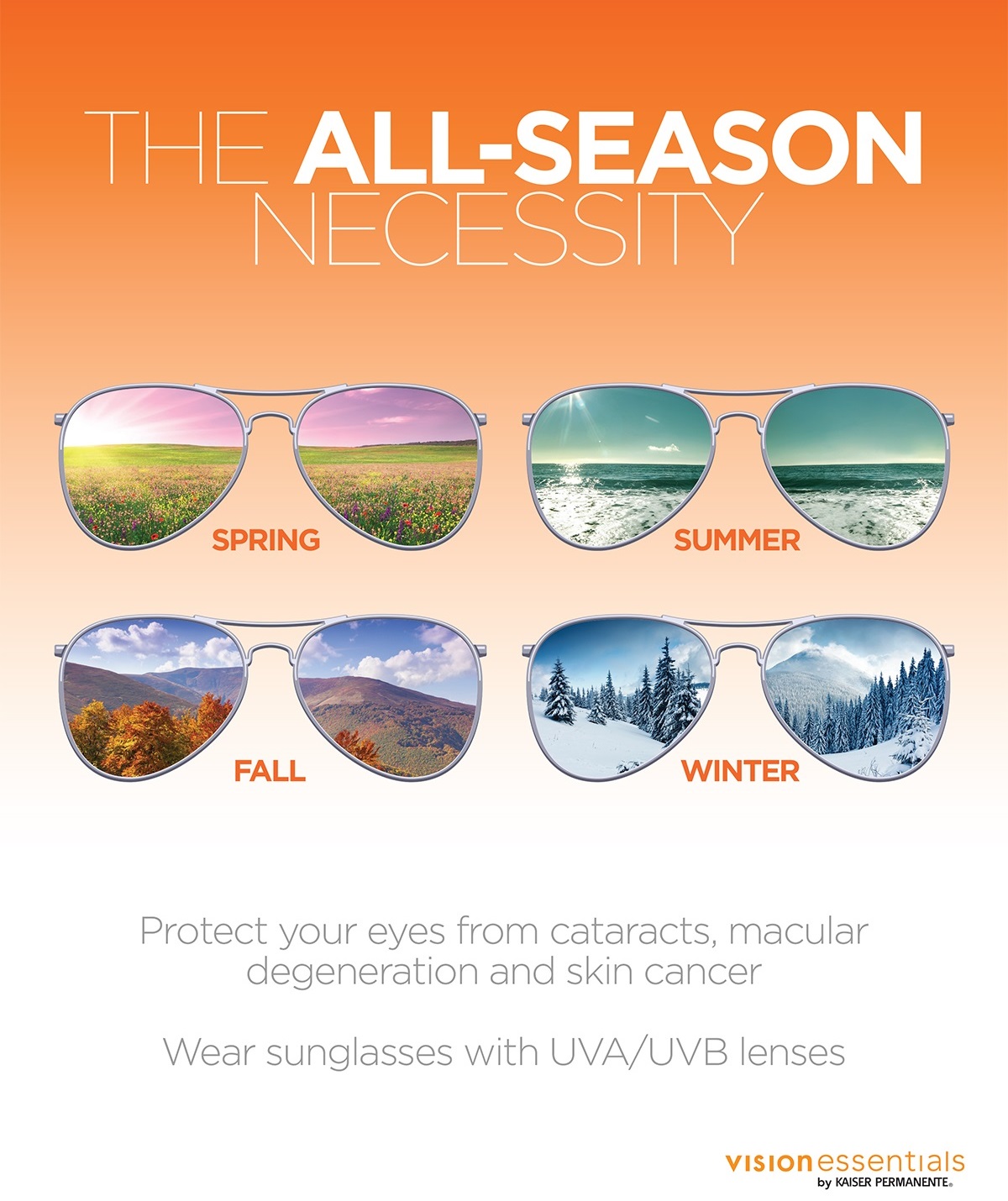Eye Care Information
At Kaiser Permanente, we’re passionate about keeping your eyes healthy and your vision sharp. Check out the information below on wearing glasses and contacts as well as eye health.
Click below to learn more.
TIPS FOR WEARING GLASSES
Putting on a new pair of prescription glasses can feel strange at first. Even if your prescription has not changed, your glasses may feel different due to a different frame or lens design. But have no fear as your eyes and brain will quickly learn if you keep wearing your new glasses and do not keep switching back to your old glasses.
Progressive glasses may take a little more time to learn, especially if you have never worn them before. Practice the following tips while wearing them to help your vision feel natural.

The location of the focal distances in progressive lens determines where to move your head or gaze to look through the correct part of the lens:
Turn your head but keep your gaze centered in the glasses when looking in the distance. Point your nose toward the object you’re looking at.

When working at your computer, look straight ahead at the monitor. Head adjustment may be needed.
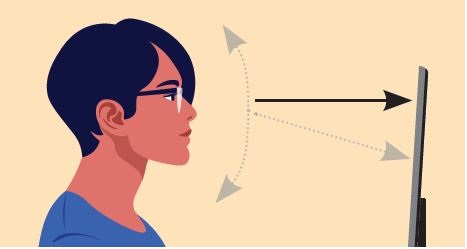
Lower just your gaze straight down to look at near objects. Do not drop your head down to read. The closer the object, the more you need to lower your gaze.

If after two weeks of wearing your new glasses and you’re still not seeing clearly, visit your Optical Center for help from an optician.
It’s normal for your vision to change over time, especially if you’re over 40 years old. Multifocal lenses help you see at a distance and read up close without having to take off or switch glasses.
Some signs to look for are:
- You hold a book or phone farther away to read
- You’re over 40 years old
- Your Optometrist prescribed multifocal lenses for you (you’ll know this if there are numbers in the “ADD” section)

Multifocal options
Complete multifocal eyewear starts at $149.1 When you use your optical benefit, you may have low to no out-of-pocket cost2.
In progressive glasses, the prescription power in your lenses changes seamlessly from distance to near vision without visible lines separating the powers in your lenses. Learn about our eyeglass lenses.

Bifocal or trifocal glasses correct only near and distance while trifocal lenses add intermediate focus with visible lines dividing the areas of focus. Learn more about our eyeglass lenses.

Computer glasses have a much larger intermediate area than a regular progressive lens, which allows you to view digital screens more comfortably. Learn more about our eyeglass lenses.
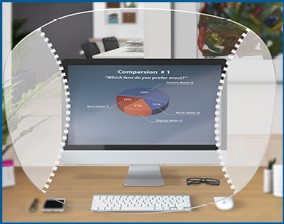
Multifocal contact lenses may be a great option for those who like the convenience of contact lenses. Multifocal contact lenses give you distance and near vision. They come in both rigid non-disposable gas permeable (RGP) and soft materials that can be disposed of daily, bi-weekly, or monthly.
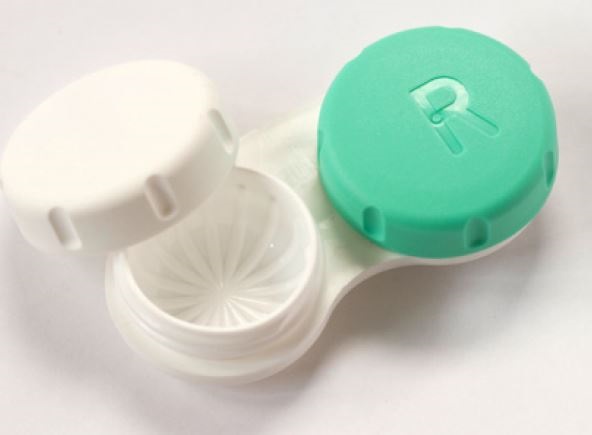
Visit your Optical Center to shop for your multifocal glasses or contacts. Need to browse for frames first? See our selection.
1Choose from our $20 frames and add standard, plastic multifocal lenses at $129.
2Check benefit availability and full benefit details.
Wearing your progressive glasses
Practice the following tips while wearing them to help your vision feel natural.
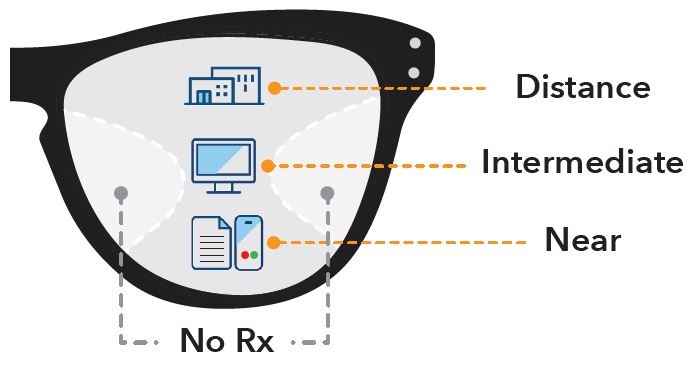
Turn your head but keep your gaze centered in the glasses when looking in the distance. Point your nose toward the object you’re looking at.

When working at your computer, look straight ahead at the monitor. Head adjustment may be needed.

Lower just your gaze straight down to look at near objects. Do not drop your head down to read. The closer the object, the more you need to lower your gaze.

If after two weeks of wearing your new glasses and you’re still not seeing clearly, visit your Optical Center for help from an optician.

A new pair may need adjustment to ensure good fit and vision. Just like a car or bicycle, your glasses may also need an occasional tune-up. Here are some tell-tale signs that you should come into your Optical Center for an adjustment at no charge:
- Glasses slide down your face when you tilt your head forward
- Glasses slip off your face when you turn your head quickly
- Bridge or nose-pads are causing pain on your nose
- Temple arms hurt the back of your ears
- Glasses leave marks on your cheeks
- You cannot see clearly or comfortably
- You need to hold your head in an unnatural position to see clearly
Visit with your Optical Center for an adjustment.

Here are some tips for keeping your glasses in great shape:
- Slide your glasses straight onto your face with both hands. Using one hand may bend the frame.
- When you’re not wearing your glasses, rest them on the frame and never on the lenses. Better yet, store them in a hard case.
- Clean your glasses with a mild, lotion-free soap. Gently apply the soap with your fingertips and rinse with warm water. You can also use lens cleaner for the lenses. Avoid harmful cleaners like rubbing alcohol or window glass cleaner.
- Dry your glasses with a clean cotton towel or micro-fiber lens cloth. Avoid drying with clothing or paper products, such as paper towels, which can scratch your lenses.
- Never leave your glasses in extreme cold or heat such as the dashboard of a car. Extreme temperatures can cause some lens coatings and frame materials to fail.
Protective cases, lens cleaner, and micro-fiber clothes are available for purchase at your Optical Center.

Moisture from your breath can fog your glasses when you wear a mask. The best way to keep your glasses from fogging is to limit the flow of air from your mask to your lenses:
- Adjust your face mask snugly around your nose and cheeks.
- Wear your glasses over the top of your mask where the mask hits your cheeks.
You can also try anti-fog sprays and wipes on your lenses. If your lenses have anti-reflective (AR) coating, make sure to find a product that is compatible. You can also try this easy trick using household ingredients:
- Mix some mild, lotion-free dish soap with warm water
- Dip your lenses in the soapy mixture
- Shake off any excess liquid
- Gently dab off any remaining liquid with a soft cloth but do not rub off the soapy film
The thin, soapy film will keep your lenses from fogging.
TIPS FOR WEARING CONTACTS
If you need vision correction, contact lenses offer a unique solution that can provide more flexibility than eyeglasses.
We offer contact lenses that correct nearsightedness, farsightedness, astigmatism, and challenging prescriptions. We also offer multifocal contacts that improve both near and distant vision.
Our team of eyecare providers will check whether contact lenses are right for your eyes.
There are three steps to getting new contact lenses today.
1. Schedule two appointments
- The first appointment with an Optometrist to exam your eyes and confirm you’re a good candidate for contact lenses.
- The second appointment with a Contact Lens Fitter to determine the type of contact lenses that will work best for you and teach you how to properly insert and remove lenses.
- Call to request both appointments for the same day when booking.
2. Schedule a follow-up appointment to finalize your contact lens prescription so you can purchase contacts.
3. Buy your lenses on kp2020.org or in one of our Optical Centers.
Your eyecare providers will help you decide which option is best for you.
-
Spherical: Have the same lens power throughout the entire contact lens to correct myopia (nearsightedness) or hyperopia (farsightedness).
-
Toric: Can correct vision for people with astigmatism.
-
Multifocal: Generally have two prescriptions (or ‘powers’) in the same lens. The two prescriptions are used to correct near vision and distance vision. There are multifocal contact lenses that will also correct astigmatism.
-
Soft: Made of soft, flexible plastics that allow oxygen to pass through to the cornea. Soft contact lenses are comfortable and easy to get used to. Soft lenses tend to be more stable making them ideal for those who are active.
-
Silicone hydrogels: An advanced type of soft contact lens material that allows more oxygen to reach the cornea.
-
Gas-permeable (GP): Rigid lenses that allow oxygen to reach the eye. Designed for increased durability and better focus.
-
Myopia management: For children 8 to 12 that may help slow the progression of nearsightedness, or myopia.
-
Specialty: Custom designed lenses for certain eye conditions.
See the three steps to getting new contact lenses today.
A contact lens wear schedule indicates the length of time you can wear and keep contact lenses. Your eyecare provider will help you decide which option is best for you.
-
Daily disposables: Throw them away after each day of use. These require no cleaning or storing.
-
Daily-wear: Meant to be cleaned after wearing and before storing them each day. Daily-wear contact lenses also have a replacement schedule of bi-weekly, monthly, quarterly, or yearly. These should be disposed of at the end of the replacement schedule.
-
Extended wear: Designed to be worn for longer periods of time, allowing users to wear them continuously throughout the day and night without having to clean them. You will dispose the contacts after the extended wear period, which can be up to 30 days. This type of lenses have a higher risk of complications such corneal problems or eye infections.
See the three steps to getting new contact lenses today.
You are responsible to care for your contacts to ensure proper eye health.
-
Stick to the specific wear schedule guidelines to avoid eye complications.
-
Practice good hygiene by washing hands thoroughly before handling contacts.
-
Use contact lens solution, changing the solution in the contact case each time you store them.
-
Replace your contact case every three months.
-
Avoid exposing contacts to water by taking them out before swimming, showering, etc.
Read more about keeping your eyes healthy while wearing contact lenses. Visit one of our Optical Centers for contact lens care products
Watch the video below to properly put in and take off contact lenses.
Watch what happens when you leave your contacts in for too long.
EYE HEALTH
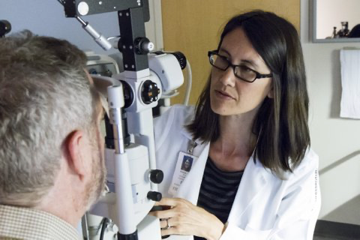
Try to arrive 15 to 20 minutes early to your eye exam to allow time to check in and update your information.
Let your Optometrist know if you are interested in contact lenses. Fitting contact lenses may involve coming back for a special fitting appointment at another time. If you already wear contact lenses, wear your contacts to your appointment. Bring your eyeglasses and any information about your current contact lenses that you have, such as boxes, vials and your last prescription.
Your Optometrist will perform a series of tests and examinations to see if your eyes are healthy. Conditions that can be detected during your eye exam include:
- Cataracts, a clouding of part or all of the lens inside the eye, resulting in blurred or distorted vision.
- Glaucoma, a disease in which the internal pressure in the eye builds up because of problems with the outflow or drainage of fluid within the eye, damaging the optic nerve and causing partial or total loss of sight.
- Macular degeneration, the loss of central vision as a result of changes, often related to aging, in the macula - that portion of the retina responsible for sharp, clear central vision.
The optometrist will then use the familiar eye chart to check if you need any vision correction. After your prescription has been determined, you will receive a written prescription for your lenses. You will then be directed to our Optical Center to work with an experienced Optician to choose the right frame and lenses for you.
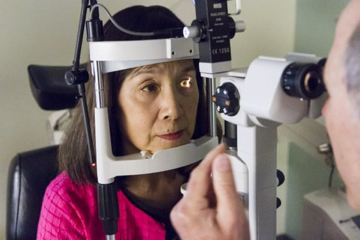
Dilated eyes allow the optometrist to look at the inside of the eye.
Not every patient needs to have a dilated examination. When dilation is necessary this is what you can expect.
Drops will be placed in each eye to enlarge the pupil (the black portion in the center of the eye). This allows the optometrist to look at the inside of the eye. You will be asked to wait for your eyes to respond to the drops and the pupils to fully dilate. Then your eyes will be examined for signs of any health problems such as
- Cataracts, a clouding of part or all of the lens inside the eye, resulting in blurred or distorted vision.
- Glaucoma, a disease in which the internal pressure in the eye builds up because of problems with the out-flow or drainage of fluid within the eye, damaging the optic nerve and causing partial or total loss of sight.
- Macular degeneration, the loss of central vision as a result of changes, often related to aging, in the macula - that portion of the retina responsible for sharp, clear central vision.
Children are screened from birth for eye disease and vision problems by their pediatricians during their regular visits. Parents are an important part of this process and need to let the pediatrician know if they notice anything unusual about their child's eyes or vision. The most common eye problems of childhood are strabismus and amblyopia.
- Strabismus refers to a crossed or turned eye. This condition tends to run in families, but can also occur spontaneously. Strabismus may require eyeglasses, or much less commonly, surgery.
- Pseudostrabismus refers to the very common situation where a child appears to have eyes that turn in due to a wide band of skin at the immature bridge of the nose. As the nose grows out, the appearance corrects itself.
- Amblyopia or "lazy eye" refers to an eye that doesn't develop vision equal to the other eye. This may be due to the eye being turned in or out, a droopy lid blocking light from entering the eye, or from a very different eyeglass lens prescription compared to the other eye. Treatment of amblyopia may require "patching," eyedrops, or eyeglasses
Children, even infants, may require eyeglasses to correct vision problems. Fitting children for eyeglasses is challenging and requires a wide array of suitable frames and an experienced staff. Our highly-trained Kaiser Permanente Optical staff loves to assist these special patients.
Children under the age of 19 who are covered by the Pediatric Essential Health Benefit may have no out-of-pocket cost for either a pair of glasses or a 6-month supply of contacts.
Call your Optical Center to check your child's specific optical benefits and availability.
Sunglasses may be a hot fashion accessory but their most important function is to protect your eyes from the sun’s damaging ultraviolet (UV) rays – even on cloudy days. Plus, harsh glare on water, snow, and even buildings can impact your vision. A good pair of sunglasses can shield your eyes and help keep them healthy. And with a wide variety of styles available you can choose a pair that matches your personal look!
Sun Dangers
- Ultraviolet (UV) light can be damaging to your eyes. UV light is considered a major cause of cataracts, eyelid cancers, and certain other skin cancers. It is believed to play a part in macular degeneration, one of the major causes of vision loss in the U.S. for people over age 60.
- Reflected glare is intensified light bouncing off natural surfaces like snow, water, cars and roads. This harsh glare can obstruct your vision and lead to eye fatigue and headaches.
Sun Solutions
- POLARIZED LENSES are the most comfortable sunglass lenses for eliminating glare and easing eye fatigue in the sun.
- PHOTOCHROMIC LENSES are specialty lenses that remain clear indoors and darken when outdoors in the presence of UV light.
- TINTED LENSES come in a rainbow of color options from light to very dark. Tints can be solid through the whole lens or gradient.
